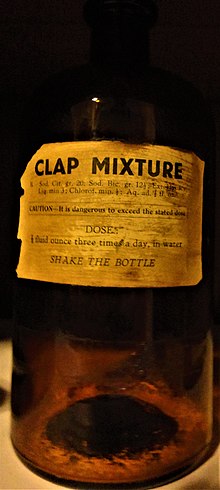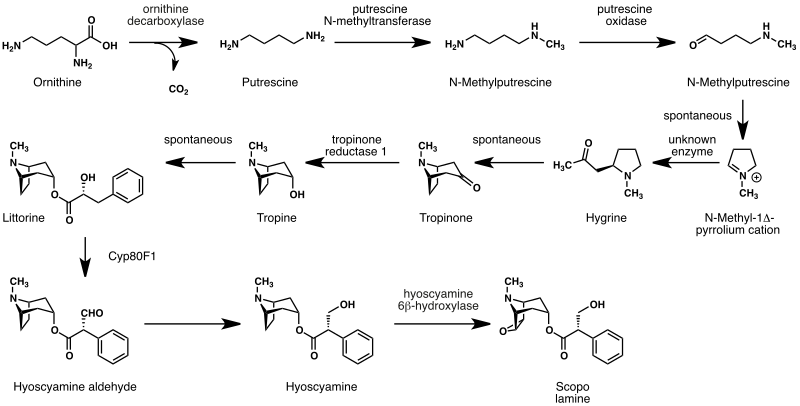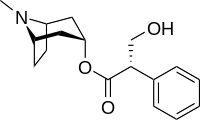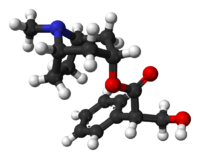Not to be confused with
hyoscine , another name for the drug scopolamine.
Tropane alkaloid
Pharmaceutical compound
Hyoscyamine Trade names Anaspaz, Levbid, Levsin AHFS /Drugs.com Monograph MedlinePlus a684010 Routes of By mouth , InjectionATC code Legal status Bioavailability 50% protein binding Metabolism Liver Elimination half-life 3–5 hrs. Excretion Kidney
(S )-(1R ,3r ,5S )-8-methyl-8-azabicyclo[3.2.1]octan-3-yl 3-hydroxy-2-phenylpropanoate
CAS Number PubChem CID DrugBank ChemSpider UNII KEGG ChEBI ChEMBL CompTox Dashboard (EPA ) ECHA InfoCard 100.002.667 Formula C 17 H 23 N O 3 Molar mass −1 3D model (JSmol )
CN3[C@H]1CC[C@@H]3C[C@@H](C1)OC(=O)[C@H](CO)c2ccccc2
InChI=1S/C17H23NO3/c1-18-13-7-8-14(18)10-15(9-13)21-17(20)16(11-19)12-5-3-2-4-6-12/h2-6,13-16,19H,7-11H2,1H3/t13-,14+,15+,16-/m1/s1
Y Key:RKUNBYITZUJHSG-FXUDXRNXSA-N
Y N Y (what is this?) (verify)
Hyoscyamine (also known as daturine or duboisine ) is a naturally occurring tropane alkaloid and plant toxin. It is a secondary metabolite found in certain plants of the family Solanaceae , including henbane , mandrake , angel's trumpets , jimsonweed , the sorcerers' tree , and Atropa belladonna (deadly nightshade). It is the levorotary isomer of atropine (third of the three major nightshade alkaloids) and thus sometimes known as levo-atropine.[ 1]
In 2021, it was the 272nd most commonly prescribed medication in the United States, with more than 900,000 prescriptions.[ 2] [ 3]
Medical uses
Hyoscyamine is used to provide symptomatic relief of spasms caused by various lower abdominal and bladder disorders including peptic ulcers , irritable bowel syndrome , diverticulitis , pancreatitis , colic , and interstitial cystitis .[ 4] [ 5] [ 6] Parkinson's disease , as well as for control of abnormal respiratory symptoms and "hyper-mucus secretions" in patients with lung disease.[ 7]
The ingredients of this Clap Mixture are sodium citrate, sodium bicarbonate, liquid extract of hyoscyamine and chloroform dissolved in water. It is also useful in pain control for neuropathic pain, chronic pain and palliative care — "comfort care" — for those with intractable pain from treatment resistant, untreatable, and incurable diseases. When combined with opioids it increases the level of analgesia (pain relief) obtained.[ 8] hyoscine and other members of the anticholinergic drug group like cyclobenzaprine , trihexyphenidyl , and orphenadrine are also used for this purpose.[ 9] ileus .[ 10]
Adverse effects
Side effects include dry mouth and throat, increased appetite leading to weight gain, eye pain, blurred vision, restlessness, dizziness, arrhythmia , flushing, and faintness.[ 5] hyoscine , as well as dicycloverine , orphenadrine , cyclobenzaprine , trihexyphenidyl , and ethanolamine antihistamines like phenyltoloxamine .[ 11] [ 12]
Pharmacology
Pharmacodynamics
Hyoscyamine is an antimuscarinic ; i.e., an antagonist of muscarinic acetylcholine receptors . It blocks the action of acetylcholine at sweat glands (sympathetic) and at parasympathetic sites in salivary glands, stomach secretions, heart muscle, sinoatrial node , smooth muscle in the gastrointestinal tract , and the central nervous system . It increases cardiac output and heart rate, lowers blood pressure and dries secretions.[ 13] serotonin .[ 14] anticholinergic power of atropine. The other major Atropa belladonna -derived drug hyoscine (known in the United States as Scopolamine) has 92 per cent of the antimuscarinic potency of atropine.[ 14]
Hyoscyamine has been described as a selective muscarinic acetylcholine M2 receptor antagonist without significant effects at the other muscarinic acetylcholine receptors.[ 15] [ 16] atropine and scopolamine , which are non-selective antagonists of all five muscarinic acetylcholine receptors.[ 15] [ 16] M1 receptor and M2 receptor has been implicated as having negative effects on memory and cognition .[ 16] deliriant effects similarly to scopolamine, atropine, and other antimuscarinics.[ 15] [ 17]
Biosynthesis in plants
Biochemistry of tropane class compounds. Hyoscyamine and scopolamine are present and labeled in the diagram. Hyoscyamine can be extracted from plants of the family Solanaceae , notably Datura stramonium precursor in the plant biosynthesis of hyoscine , it is produced via the same metabolic pathway .[ 18]
The biosynthesis of hyoscine begins with the decarboxylation of L -ornithine to putrescine by ornithine decarboxylase (EC 4.1.1.17 ). Putrescine is methylated to N -methylputrescine by putrescine N -methyltransferase (EC 2.1.1.53 ).[ 18]
A putrescine oxidase (EC 1.4.3.10 ) that specifically recognizes methylated putrescine catalyzes the deamination of this compound to 4-methylaminobutanal which then undergoes a spontaneous ring formation to N -methylpyrrolium cation. In the next step, the pyrrolium cation condenses with acetoacetic acid yielding hygrine . No enzymatic activity could be demonstrated that catalyzes this reaction. Hygrine further rearranges to tropinone .[ 18]
Subsequently, tropinone reductase I (EC 1.1.1.206 ) converts tropinone to tropine which condenses with phenylalanine -derived phenyllactate to littorine. A cytochrome P450 classified as Cyp80F1[ 19] aldehyde .
Bush medicine basis
A bush medicine developed by Aboriginal peoples of the eastern states of Australia from the soft corkwood tree, or Duboisia myoporoides Allies in World War II to stop soldiers getting seasick when they sailed across the English Channel during the Invasion of Normandy . Later, it was found that the same substance could be used in the production of scopolamine and hyoscyamine, which are used in eye surgery , and a multi-million dollar industry was built in Queensland based on this substance.[ 20]
Society and culture
Brand names
Brand names for hyoscyamine include Symax, HyoMax, Anaspaz, Egazil, Buwecon, Cystospaz, Levsin, Levbid, Levsinex, Donnamar, NuLev, Spacol T/S, and Neoquess.[ 21]
References
^ Ushimaru R, Ruszczycky MW, Liu HW (January 2019). "Changes in Regioselectivity of H Atom Abstraction during the Hydroxylation and Cyclization Reactions Catalyzed by Hyoscyamine 6β-Hydroxylase" . Journal of the American Chemical Society . 141 (2): 1062– 1066. Bibcode :2019JAChS.141.1062U . doi :10.1021/jacs.8b11585 . PMC 6488026 PMID 30545219 . ^ "The Top 300 of 2021" . ClinCalc . Archived from the original on 15 January 2024. Retrieved 14 January 2024 .^ "Hyoscyamine - Drug Usage Statistics" . ClinCalc . Retrieved 14 January 2024 .^ National Clinical Guideline Centre (UK) (2012). Treatment to improve bladder storage Royal College of Physicians . p. 83 – via National Library of Medicine . ^ a b "Hyoscyamine Uses, Side Effects & Warnings" . Drugs.com Archived from the original on 20 August 2022. Retrieved 20 August 2022 .^ "Bladder Control Medicines | NIDDK" . National Institute of Diabetes and Digestive and Kidney Diseases Archived from the original on 20 August 2022. Retrieved 20 August 2022 .^ "Hyoscyamine: MedlinePlus Drug Information" . medlineplus.gov Archived from the original on 20 August 2022. Retrieved 20 August 2022 .^ Harden RN (March 2005). "Chronic neuropathic pain. Mechanisms, diagnosis, and treatment". The Neurologist . 11 (2): 111– 122. doi :10.1097/01.nrl.0000155180.60057.8e . PMID 15733333 . S2CID 12602416 . ^ Ali-Melkkilä T, Kanto J, Iisalo E (October 1993). "Pharmacokinetics and related pharmacodynamics of anticholinergic drugs". Acta Anaesthesiologica Scandinavica . 37 (7): 633– 642. doi :10.1111/j.1399-6576.1993.tb03780.x . PMID 8249551 . S2CID 22808654 . ^ Kamimura A, Howard S, Weaver S, Panahi S, Ashby J (December 2020). "The Use of Complementary and Alternative Medicine Strategies, Opioids, and Nonsteroidal Anti-Inflammatory Drugs (NSAIDS) Among Patients Attending a Free Clinic" . Journal of Patient Experience . 7 (6): 1701– 1707. doi :10.1177/2374373520937514 . PMC 7786764 PMID 33457633 . ^ Kang M, Galuska MA, Ghassemzadeh S (2022). "Benzodiazepine Toxicity" . StatPearls . Treasure Island (FL): StatPearls Publishing. PMID 29489152 . Archived from the original on 20 August 2022. ^ "Hyoscyamine Sulfate Sublingual Tablets, 0.125 mgRx Only" . www.dailymed.nlm.nih.gov . Archived from the original on 20 August 2022. Retrieved 20 August 2022 .^ Edwards Pharmaceuticals, Inc., Belcher Pharmaceuticals, Inc. (May 2010). "DailyMed" . U.S. National Library of Medicine. Retrieved 13 January 2013 . ^ a b Kapoor AK, Raju SM (2013). Illustrated Medical Pharmacology ISBN 9789350906552 . Retrieved 11 January 2014 . ^ a b c Lakstygal AM, Kolesnikova TO, Khatsko SL, Zabegalov KN, Volgin AD, Demin KA, et al. (May 2019). "DARK Classics in Chemical Neuroscience: Atropine, Scopolamine, and Other Anticholinergic Deliriant Hallucinogens". ACS Chem Neurosci . 10 (5): 2144– 2159. doi :10.1021/acschemneuro.8b00615 . PMID 30566832 . ^ a b c Shim KH, Kang MJ, Sharma N, An SS (September 2022). "Beauty of the beast: anticholinergic tropane alkaloids in therapeutics" . Nat Prod Bioprospect . 12 (1): 33. doi :10.1007/s13659-022-00357-w . PMC 9478010 PMID 36109439 . Antagonism at M1 and M2 receptors have negative impact on memory and cognition [60]. [...] Atropine and scopolamine are non-selective competitive antagonist of muscarinic receptors. Atropine has the highest affinity for subtype M1, followed by M2 and M3 and weak affinity for M4 and M5 [71]. On the other hand, scopolamine has strong affinity for M1-M4 compared to M5 [72] while hyoscyamine binds to M2 only [73]. ^ Lavrador M, Cabral AC, Veríssimo MT, Fernandez-Llimos F, Figueiredo IV, Castel-Branco MM (January 2023). "A Universal Pharmacological-Based List of Drugs with Anticholinergic Activity" . Pharmaceutics . 15 (1): 230. doi :10.3390/pharmaceutics15010230 PMC 9863833 PMID 36678858 . ^ a b c Ziegler J, Facchini PJ (2008). "Alkaloid biosynthesis: metabolism and trafficking". Annual Review of Plant Biology . 59 (1): 735– 769. doi :10.1146/annurev.arplant.59.032607.092730 . PMID 18251710 . ^ Li R, Reed DW, Liu E, Nowak J, Pelcher LE, Page JE, et al. (May 2006). "Functional genomic analysis of alkaloid biosynthesis in Hyoscyamus niger reveals a cytochrome P450 involved in littorine rearrangement" . Chemistry & Biology . 13 (5): 513– 520. doi :10.1016/j.chembiol.2006.03.005 PMID 16720272 . ^ "Visitors to Art of Healing exhibition told how Australian Indigenous bush medicine was given to every allied soldier landing at Normandy on D-Day" . King's College London . 7 June 2019. Retrieved 2 June 2020 .^ "Hyoscyamine - brand name list from Drugs.com" . Drugs.com Archived from the original on 20 August 2022. Retrieved 20 August 2022 .
Plants / animals Preparations Compounds People
Psychedelics (5-HT2A
Benzofurans Lyserg‐ Phenethyl‐
2C-x
3C-x 4C-x DOx HOT-x MDxx Mescaline (subst.) TMAs
TMA
TMA-2
TMA-3
TMA-4
TMA-5
TMA-6 Others
Piperazines Tryptamines
alpha -alkyltryptaminesx -DALT x -DET x -DiPT x -DMT
4,5-DHP-DMT 2,N,N-TMT 4-AcO-DMT 4-HO-5-MeO-DMT 4,N,N-TMT 4-Propionyloxy-DMT 5,6-diBr-DMT 5-AcO-DMT 5-Bromo-DMT 5-MeO-2,N ,N -TMT 5-MeO-4,N ,N -TMT 5-MeO-α,N,N-TMT 5-MeO-DMT 5-N ,N -TMT 7,N,N-TMT α,N,N-TMT (Bufotenin) 5-HO-DMT DMT Norbaeocystin (Psilocin) 4-HO-DMT (Psilocybin) 4-PO-DMT x -DPT Ibogaine-related x -MET x -MiPT Others
Others
Dissociatives (NMDAR antagonists )
Deliriants (mAChR antagonists ) Others
mAChRs Tooltip Muscarinic acetylcholine receptors
Agonists Antagonists
3-Quinuclidinyl benzilate 4-DAMP Aclidinium bromide (+formoterol )Abediterol AF-DX 250 AF-DX 384 Ambutonium bromide Anisodamine Anisodine Antihistamines (first-generation) (e.g., brompheniramine , buclizine , captodiame , chlorphenamine (chlorpheniramine) , cinnarizine , clemastine , cyproheptadine , dimenhydrinate , dimetindene , diphenhydramine , doxylamine , meclizine , mequitazine , perlapine , phenindamine , pheniramine , phenyltoloxamine , promethazine , propiomazine , triprolidine )AQ-RA 741 Atropine Atropine methonitrate Atypical antipsychotics (e.g., clozapine , fluperlapine , olanzapine (+fluoxetine ), rilapine , quetiapine , tenilapine , zotepine )Benactyzine Benzatropine (benztropine) Benzilone Benzilylcholine mustard Benzydamine Bevonium BIBN 99 Biperiden Bornaprine Camylofin CAR-226,086 CAR-301,060 CAR-302,196 CAR-302,282 CAR-302,368 CAR-302,537 CAR-302,668 Caramiphen Cimetropium bromide Clidinium bromide Cloperastine CS-27349 Cyclobenzaprine Cyclopentolate Darifenacin DAU-5884 Desfesoterodine Dexetimide DIBD Dicycloverine (dicyclomine) Dihexyverine Difemerine Diphemanil metilsulfate Ditran Drofenine EA-3167 EA-3443 EA-3580 EA-3834 Emepronium bromide Etanautine Etybenzatropine (ethybenztropine) Fenpiverinium Fentonium bromide Fesoterodine Flavoxate Glycopyrronium bromide (+beclometasone/formoterol , +indacaterol , +neostigmine )Hexahydrodifenidol Hexahydrosiladifenidol Hexbutinol Hexocyclium Himbacine HL-031,120 Homatropine Imidafenacin Ipratropium bromide (+salbutamol )Isopropamide J-104,129 Hyoscyamine Mamba toxin 3 Mamba toxin 7 Mazaticol Mebeverine Meladrazine Mepenzolate Methantheline Methoctramine Methylatropine Methylhomatropine Methylscopolamine Metixene Muscarinic toxin 7 N-Ethyl-3-piperidyl benzilate N-Methyl-3-piperidyl benzilate Nefopam Octatropine methylbromide (anisotropine methylbromide) Orphenadrine Otenzepad (AF-DX 116) Otilonium bromide Oxapium iodide Oxitropium bromide Oxybutynin Oxyphencyclimine Oxyphenonium bromide PBID PD-102,807 PD-0298029 Penthienate Pethidine pFHHSiD Phenglutarimide Phenyltoloxamine Pipenzolate bromide Piperidolate Pirenzepine Piroheptine Pizotifen Poldine Pridinol Prifinium bromide Procyclidine Profenamine (ethopropazine) Propantheline bromide Propiverine Quinidine 3-Quinuclidinyl thiochromane-4-carboxylate Revefenacin Rociverine RU-47,213 SCH-57,790 SCH-72,788 SCH-217,443 Scopolamine (hyoscine) Scopolamine butylbromide (hyoscine butylbromide) Silahexacyclium Sofpironium bromide Solifenacin SSRIs Tooltip Selective serotonin reuptake inhibitors (e.g., femoxetine , paroxetine )Telenzepine Terodiline Tetracyclic antidepressants (e.g., amoxapine , maprotiline , mianserin , mirtazapine )Tiemonium iodide Timepidium bromide Tiotropium bromide Tiquizium bromide Tofenacin Tolterodine Tricyclic antidepressants (e.g., amitriptyline (+perphenazine ), amitriptylinoxide , butriptyline , cidoxepin , clomipramine , desipramine , desmethyldesipramine , dibenzepin , dosulepin (dothiepin) , doxepin , imipramine , lofepramine , nitroxazepine , northiaden (desmethyldosulepin) , nortriptyline , protriptyline , quinupramine , trimipramine )Tridihexethyl Trihexyphenidyl Trimebutine Tripitamine (tripitramine) Tropacine Tropatepine Tropicamide Trospium chloride Typical antipsychotics (e.g., chlorpromazine , chlorprothixene , cyamemazine (cyamepromazine) , loxapine , mesoridazine , thioridazine )Umeclidinium bromide (+vilanterol )WIN-2299 Xanomeline Zamifenacin
Precursors (and prodrugs )




